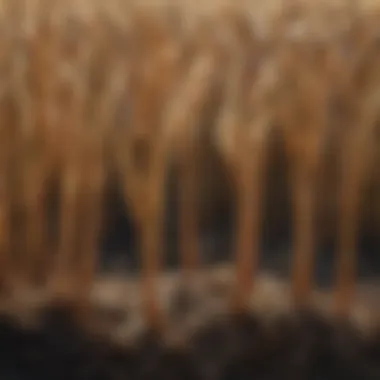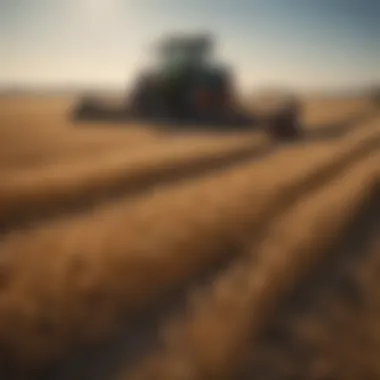Exploring Winter Wheat as a Cover Crop Seed


Intro
In the landscape of modern agriculture, the role of cover crops often gets overshadowed by high-yield cash crops. However, the significance of winter wheat as a cover crop seed serves as a reminder of the delicate balance within farming ecosystems. Cover crops like winter wheat are not merely nuisance plants; they are invaluable tools that support sustainable farming practices and enhance soil health.
Farmers and agricultural enthusiasts alike often overlook the potential of these cover crops. By using winter wheat, they can enrich soil nutrients, prevent erosion, and improve overall crop yields in the subsequent planting seasons. As we delve deeper into this topic, it’s essential to grasp not just what winter wheat is or how it’s used, but also its broader implications on the environment and economy.
The effectiveness of winter wheat as a cover crop is rooted in its agronomic properties, adaptability across various climates, and the economic advantages it presents. This article aims to equip you with a comprehensive understanding of all these aspects, from the very essence of winter wheat to its practical applications in varied farming systems.
Prolusion to Winter Wheat Cover Crop Seed
The landscape of modern agriculture is evolving, with sustainability at its helm. One of the unsung heroes in this realm is winter wheat, especially when it’s used as a cover crop. This section serves as a launchpad to grasp the multifaceted advantages and considerations associated with winter wheat cover crop seed. Understanding this topic is essential for farmers and agricultural enthusiasts alike, providing insights into practices that foster better soil health and overall ecosystem vitality.
The importance of winter wheat as a cover crop transcends mere cultivation. It acts as a sophisticated buffer to tackle various agricultural obstacles like soil erosion, nutrient depletion, and pest invasion. Farmers implementing this cover crop encounter a cascade of benefits, from improved soil structure and moisture retention to enhanced biodiversity. Moreover, the historical context adds depth to its significance—it shows how communities have relied on winter wheat for generations, tying together tradition and innovation in agricultural practices.
Through this exploration, we will delve into:
- Defining Cover Crops: Clarifying the concept of cover crops and their role within agricultural systems.
- Historical Context of Winter Wheat: Providing a backdrop that contextualizes the relevance of winter wheat over the ages, showcasing its journey through agricultural practices.
This comprehension is tailored for those who operate within the soil, ensuring that every seed planted contributes not only to the immediate yield but also the long-term health of the land.
"Cover crops, like winter wheat, create a symbiotic relationship with the soil, yielding a harvest that goes beyond the tangible."
By the end of this section, you should appreciate the intrinsic value of winter wheat cover crop seed, fostering a deeper connection between agricultural practices and sustainable farming principles.
Agronomic Advantages of Winter Wheat as a Cover Crop
When diving into the world of agricultural practices, the advantages that winter wheat provides as a cover crop demand careful consideration. Not only does it enhance soil quality, but it also plays a pivotal role in promoting sustainable farming. Understanding these benefits can help farmers optimize their yields while taking care of their land.
Soil Erosion Prevention
Soil erosion has been a headache for farmers, with its ability to strip away nutrient-rich topsoil. Winter wheat, with its robust root system, acts like a sponge. It locks the soil in place, minimizing the likelihood of erosion during heavy rains or windy conditions. Some farmers have noticed a remarkable difference post-winter when comparing fields, with significant retention in areas planted with winter wheat versus those without.
- Why this matters:
The importance of maintaining soil integrity cannot be overstated. Eroded soil not only results in direct financial losses for farmers but also contributes to environmental degradation. Incorporating winter wheat helps arrest this cycle, which is a win-win for agriculture and ecology.
Nutrient Retention
Another shining advantage of using winter wheat is its ability to retain key nutrients within the soil. During the off-season, the crop absorbs nitrogen, which can often leach away due to rainfall and irrigation. This retention plays a critical role in maintaining soil fertility.
Recent studies indicate that fields with winter wheat can exhibit up to 30% less nitrogen loss compared to untreated plots. This means less need for synthetic fertilizers later, leading to both economic savings and a lower environmental footprint.
- Key nutrients supported:
- Nitrogen
- Phosphorous
- Potassium
Weed Suppression
Weeds often feel like uninvited guests at a dinner party; they take away resources that your crops desperately need. Thankfully, winter wheat serves as a natural competitor to these invasive plants. By establishing a canopy over the soil, it starves weeds of sunlight and space, leading to reduced weed pressure come springtime.
Farmers have noted that areas planted with winter wheat witness up to a 50% decrease in weed populations. This not only saves time and money when it comes to herbicide applications but also contributes to a healthier ecosystem, reducing chemical runoff.
"Integrating winter wheat into our cover crop system has been transformative: healthier soil, less weed management headaches, and better nutrient levels—what's not to like?"
— Local farmer, Green Valley Region
Best Practices for Planting Winter Wheat
Planting winter wheat is about more than just sticking seeds in the ground; it’s a careful art that blends timing, technique, and strategy to yield optimal results. Understanding the best practices for this process can truly make or break a farmer’s efforts in utilizing winter wheat as a cover crop. Each step carries its own importance, delving into aspects such as timing, seeding rates, and soil preparation. This section aims to equip farmers and agricultural enthusiasts with essential guidelines that ensure robust growth and sustainable practices.
Timing of Planting
Getting the timing right for planting winter wheat is crucial. Ideally, it is best to plant winter wheat about two to three weeks before the first expected frost. This allows the seeds to germinate and establish a solid root system before the winter chill sets in. Planting too early may lead to excess growth that can be damaged by frost. On the other hand, waiting too long can hinder germination, risking a poor stand.
Farmers should keep track of regional climate patterns and consider variables like soil temperature and moisture. The soil should be between 50°F and 86°F for optimal germination. A mistake in timing could mean the difference between a flourishing cover crop and merely a handful of sprouted seeds.
Seeding Rates and Depths
When it comes to seeding rates, winter wheat is generally sown at a higher density compared to other crops. A common recommendation is to plant around one to two million seeds per acre. However, the exact rate can vary depending on specific environmental conditions and the intended purpose of the cover crop. If the aim is to enhance soil cover and improve biomass production, consider leaning towards the higher range.


Appropriate seeding depth is just as vital. Ideally, seeds should be planted around one to two inches deep. If planted too shallow, seeds could dry out or be consumed by birds; if too deep, they may not have enough energy to break the ground. Achieving that sweet spot can promote rapid establishment and vigorous growth.
Soil Preparation Techniques
Preparing the soil properly is a foundational step in the planting process. Before sowing, the soil should be well-aerated and free from clumps. Tilling can help break up compacted layers and allow air and moisture to penetrate better. It's also essential to remove debris like stones, which could hinder sprouting.
Conducting a soil test can provide crucial information about pH levels and nutrient availability. Adjustments can be made based on the results, such as adding lime to raise pH or incorporating compost to enhance organic matter content. A well-prepared seedbed leads to improved seed-to-soil contact, ultimately increasing the chances of successful germination.
A well-timed, well-prepared planting process can lead to a cover crop that enriches soil health and promotes ecological balance, ultimately enhancing agricultural yields.
Engaging in these best practices can contribute substantially to a successful winter wheat cover crop planting, supporting sustainable farming and enriching soil health for future agricultural cycles.
Management Strategies for Winter Wheat Cover Crops
Effective management strategies for winter wheat cover crops are central to nurturing soil health and ensuring sustainable agricultural practices. They serve as the backbone for maximizing the benefits winter wheat can bring to farming systems. With its potential to improve soil structure, enhance nutrient cycling, and suppress unwanted weeds, it’s vital to implement smart management techniques.
Irrigation Needs
Water management is key in establishing a successful winter wheat cover crop. While winter wheat is relatively drought-tolerant, strategically managing irrigation during its growth phase can lead to improved yields and healthier soil.
- Soil Moisture Monitoring: Keep an eye on your soil moisture levels. Utilize soil moisture sensors or even a simple finger test. If your soil feels dry an inch below the surface, it might be time to irrigate.
- Timing Matters: Providing water during critical growth periods, such as seed germination and tillering, can significantly boost establishment rates.
- Efficient Systems: Invest in drip irrigation or other efficient methods to minimize water waste. Not only does this ensure the cover crop gets what it needs, but it also protects the surrounding environment from over-irrigation.
In many cases, understanding local climate patterns plays a pivotal role. This information aids in making timely irrigation decisions that align with seasonal weather changes.
Fertilization Regimens
Getting the fertilization strategy right can greatly enhance the effectiveness of winter wheat as a cover crop. Fertility isn't a one-size-fits-all approach, and here are some considerations:
- Soil Testing: Conducting a thorough soil test before planting can help in determining nutrient needs. Look for deficiencies in nitrogen and phosphorus, as they are critical for early growth.
- Incorporating Organic Matter: Adding compost or well-rotted manure can improve soil fertility. Organic matter serves as a slow-release fertilizer while boosting soil structure and water retention capabilities.
- Timing Fertilization: Applying fertilizer at the right time is crucial. A pre-planting application can kick-start growth, but a side-dress application during the growth phase can be more effective when the crop really needs it.
A responsive fertilization regimen aligned with crop needs can facilitate robust growth through to maturity.
Pest and Disease Management
Managing pests and diseases is another critical piece of the puzzle. Winter wheat, like any crop, faces various threats, so having a comprehensive plan is essential.
- Regular Monitoring: Create a schedule for routine checks on your crops. Look for signs of common pests like aphids or fungal diseases. Early detection can make all the difference.
- Integrated Pest Management (IPM): Use an IPM approach that incorporates biological controls, cultural practices, and chemical options, if necessary. For example, introducing beneficial insects can help keep pest populations in check.
- Crop Rotation: Consider rotating winter wheat with other crops to disrupt the lifecycle of pests and pathogens. This practice reduces disease buildup in the soil.
Managing pests and diseases effectively will not only improve winter wheat health but will also lead to a more resilient farming system overall.
"The essence of management strategies lies not just in adhering to practices but in adapting to the unique challenges of each season."
By implementing effective management strategies tailored to winter wheat cover crops, farmers can improve soil health, enhance crop performance, and secure their standing in sustainable farming practices. The integration of these techniques helps in nurturing a robust agricultural system that thrives through cooperation with nature.
Ecological Impact of Winter Wheat Cover Crops
The ecological impact of winter wheat cover crops goes beyond agricultural practices, intertwining with broader environmental concerns. As climate change looms and sustainability becomes increasingly critical, understanding how these cover crops function in ecosystems is essential. They present numerous benefits that can significantly enhance soil health and ecological balance. Key aspects to consider include biodiversity enhancement and carbon sequestration, both of which play vital roles in fostering robust agricultural systems and a healthier planet.
Biodiversity Enhancement
Incorporating winter wheat as a cover crop invites a wider range of life into farming ecosystems. When fields are covered with this crop, they can provide habitats for various beneficial organisms. For instance, insects like ladybugs and bees find refuge, contributing to pest control and pollination respectively. Moreover, the presence of diverse plants supports more avian species that prey on crop pests.
Growing winter wheat alongside other species can lead to the phenomenon known as companion planting. This practice boosts plant diversity, encouraging an increase in beneficial microbes within the soil. More diverse plant life can also improve the resilience of the ecosystem overall, as different plants can cope with varying environmental stresses like droughts or floods more effectively than uniform crops.
- Diverse Microbial Populations: Fertile soil thrives on diverse microbial life. A variety of cover crops can enhance the diversity of soil bacteria and fungi, which is crucial for nutrient cycling.
- Interconnected Food Webs: More plant species mean more food opportunities, which in turn strengthens food webs within an ecosystem.
Carbon Sequestration
The role of winter wheat cover crops in carbon sequestration is another aspect that cannot be overlooked. Through photosynthesis, these plants capture carbon dioxide from the atmosphere and store it in their biomass and the soil. This process is pivotal in combating climate change, as it mitigates greenhouse gas levels.
Evidence suggests that integrating winter wheat cover crops can enhance soil organic matter, leading to improved soil structure and increased fertility. Healthy soil with high organic content is more effective at retaining water, thereby reducing irrigation costs and improving crop yields.
- Soil Health: An increase in organic matter improves soil aeration and water infiltration, further promoting plant growth.
- Atmospheric Impact: By pulling more carbon into the soil, farmers can contribute to reduced atmospheric CO2 levels, playing a small yet meaningful role in global climate regulation.
"Cover crops like winter wheat can be a farmer's best friend, serving dual roles as both an ecological steward and a cost-effective strategy in the quest for sustainable agriculture."
In summary, the ecological impact of winter wheat cover crops encompasses more than just agricultural benefits. By enhancing biodiversity and facilitating carbon sequestration, they contribute to the overall health of the environment. As more farmers adopt these practices, the potential ripple effects on ecological systems become increasingly significant.


Economic Considerations of Winter Wheat Cover Crops
Cost-Benefit Analysis
When evaluating the use of winter wheat as a cover crop, a detailed cost-benefit analysis becomes critical. Not only is this analysis foundational to assessing the viability of integration into existing farming operations, but it also outlines the potential return on investment for farmers. On one hand, the initial costs may include seeds, labor for planting, and various inputs needed for maintenance. Farmers must consider how these expenses stack up against potential savings from reduced soil erosion, improved soil health, and the benefits of enhanced crop yields in subsequent seasons.
A thorough cost-benefit breakdown might look like the following:
- Initial Costs:
- Ongoing Expenses:
- Savings and Gains:
- Seeds: Prices vary by variety; select high-yield options for longer-term benefits.
- Labor: Time spent planting and managing these crops needs to be estimated realistically.
- Fertilizers/Pesticides: May be necessary, though winter wheat generally requires less than cash crops.
- Erosion Control: Reduced loss of topsoil can save on future land remediation costs.
- Nutrient Management: Better retention means possible reductions in synthetic fertilizers.
- Improved Yields: An increase in the yield of subsequent crops can often justify the overhead.
Calculating these factors allows farmers to tailor their approach based on local conditions and specific farming methodologies. For instance, a farmer in a region with severe erosion might find the benefits of winter wheat to be more pronounced and worth the investment compared to someone in an area with stable soils.
Market Demand and Pricing Dynamics
Understanding the market dynamics around winter wheat is essential for making informed decisions. The demand for winter wheat varies, influenced by various factors such as global production levels, changes in consumer preferences, and evolving agricultural practices.
From a pricing perspective, winter wheat often serves as a buffer crop, meaning its price fluctuations can be affected by the market conditions of primary grains like corn or soybeans. The following points capture the essence of the current market landscape:
- Supply and Demand: When global crop yields are strong, prices can dip, benefiting those looking to use winter wheat as a low-cost cover option. Conversely, low yields can drive prices up, impacting the purchase decisions for farmers.
- Regional Variations: Market conditions can differ significantly from one region to another, affecting local prices. Familiarity with the local market can empower farmers to make strategic decisions about whether to plant winter wheat based on anticipated return.
- Consumer Preferences: There’s a growing trend toward sustainable agriculture. Winter wheat products are increasingly sought after in consumer markets, boosting demand and sometimes leading to premium pricing options for those who commit to growing these crops responsibly.
In sum, keeping a finger on the pulse of market trends and understanding local economic dynamics can provide a competitive edge for farmers considering winter wheat as a cover crop. By doing so, they can make strategic decisions that ultimately lead to a more sustainable and economically viable farming operation.
"Understanding economic considerations is not just about counting beans; it's about paving the way for future growth and sustainability in agriculture."
Integration with Crop Rotation Systems
When it comes to sustainable agriculture, the interaction between winter wheat cover crops and crop rotation systems cannot be ignored. This integration plays a pivotal role in enhancing soil health and maximizing yields. Farmers must recognize that rotational practices are not just about planting different crops; they involve carefully timing and swapping various species to benefit the ecosystem.
Benefits of Crop Rotation
Integrating winter wheat within a crop rotation system offers various benefits:
- Soil Fertility Improvement: Growing winter wheat alternately with legumes can boost nitrogen levels due to the legumes fixing nitrogen in the soil, thus reducing the need for synthetic fertilizers.
- Pest and Disease Management: Rotating crops helps disrupt pest life cycles. For instance, planting wheat after a broadleaf crop can minimize the risk of diseases specific to those plants, leading to healthier crops overall.
- Weed Control: By alternating crops with different growth patterns, you reduce the chances of weeds establishing a stronghold. Winter wheat, with its dense growth habit, can suppress weeds when managed correctly.
Farmers who adopt these methods often find they spend a bit less on inputs, and their land responds favorably in terms of moisture retention and biodiversity.
Case Studies of Successful Integrations
Real-world examples illustrate the potential of integrating winter wheat into crop rotations. For instance, a farmer in Indiana adopted a three-year rotation model: soybeans, followed by winter wheat, and then corn. This approach not only improved overall soil health but also resulted in a considerable increase in yields and profits over time. Farmers in similar regions reporting up to a 20% increase in corn yields after incorporating winter wheat into their rotation.
Another noteworthy case can be seen in the Pacific Northwest, where winter wheat serves as a cover crop in potato fields. This strategic pairing has led to a significant reduction in soil erosion and an improvement in water retention, which are essential in that arid climate.
"A well-planned rotation is like a well-tuned orchestra; each part plays a role that enhances the overall harmony."
In summary, the integration of winter wheat in crop rotation presents a multitude of benefits, not just agronomically but economically as well. It ultimately reflects the need for a thoughtful approach to maintaining the earth's resources while ensuring productive outputs for farmers.
Challenges in Using Winter Wheat as a Cover Crop
While winter wheat holds significant promise as a cover crop, its adoption does not come without hurdles. Farmers and agronomists must navigate various obstacles, both environmental and market-related, that could hinder effective use. Understanding these challenges is crucial, as they shape decision-making and influence the potential benefits that winter wheat could provide to sustainable agricultural practices.
Environmental Constraints
One of the key challenges associated with using winter wheat as a cover crop revolves around environmental constraints. Winter wheat, while resilient in many climates, has specific growth conditions that can limit its effectiveness as a cover crop in certain areas. For instance, regions that experience extreme cold can adversely affect seed germination and establishment. In addition, excessive rainfall or poorly drained soils can lead to flooding, which not only hampers the growth of winter wheat but also can promote disease development in the crop.
Moreover, it's essential to consider the local pest and weed populations that may thrive in winter conditions. For example, some areas may experience a higher incidence of pests during mild winters, leading to potential crop damage. This is particularly concerning for winter wheat, which might already be stressed from environmental factors.
As a cover crop, winter wheat should ideally thrive without adding to the farmers' woes. Managing these environmental factors, therefore, becomes paramount. Farmers often need to evaluate soil health, local climate patterns, and even historical pest outbreaks to gauge the viability of winter wheat in their specific conditions.
Market Fluctuations
On another front, market fluctuations represent another significant challenge when utilizing winter wheat as a cover crop. The economic viability of planting winter wheat can be volatile and heavily influenced by external market factors. For starters, if the price of wheat is low, some farmers might hesitate to invest in planting it as a cover crop, figuring that the cost might not match the returns. Conversely, if market prices soar, the same farmers may divert their winter wheat to cash cropping instead of using it for soil health.


Moreover, supply chain issues can create further instability. The availability of quality seeds for winter wheat can fluctuate due to various regions experiencing different growing conditions. A decrease in seed availability can drive prices up, making it less appealing for farmers to include on their lists. Furthermore, farmer co-ops, seed suppliers, and farming associations often fluctuate in prices, causing farmers to constantly reassess their strategies.
"Farmers often find themselves in a balancing act, weighing the benefits of planting winter wheat against the shifting dynamics of market prices and seed availability."
Legality and Regulatory Considerations
When it comes to the use of winter wheat as a cover crop, understanding the legality and regulatory considerations is a crucial step for farmers and agricultural stakeholders. Various guidelines established by government bodies can directly impact how winter wheat is planted and managed. Moreover, these regulations ensure that sustainable agricultural practices are maintained, benefiting both the environment and farming communities.
Government Guidelines
Each region may have specific government guidelines regarding cover crops, including winter wheat. These often focus on:
- Planting dates: Timing can be vital in ensuring the crop thrives and meets its objectives.
- Crop rotation requirements: Some jurisdictions mandate certain rotations to enhance soil health and prevent pest buildups.
- Pesticide and fertilizer use: Regulations can restrict specific chemicals during the winter wheat's growth period to protect environmental integrity.
Adhering to these guidelines is paramount. Failing to comply can lead to penalties and potentially compromise funding opportunities or participation in government programs. Farmers should always consult local extension services or agricultural departments to ensure they are up to speed with current regulations.
Funding Opportunities and Grants
Navigating the landscape of funding opportunities and grants can be daunting, but it's worth the effort, especially for those incorporating winter wheat as a cover crop. Various federal and state programs offer financial assistance, making sustainable practices more accessible. Key points to note include:
- USDA Programs: The United States Department of Agriculture often provides financial aid for cover crop initiatives, including grants targeted at sustainable farming.
- State-specific grants: Many states have their own programs that support cover cropping. Researching state resources can reveal niche funding options.
- Environmental Quality Incentives Program (EQIP): This is a popular choice among farmers looking for substantial support in implementing conservation practices, including the use of winter wheat as a cover crop.
By strategically leveraging these funding opportunities, farmers can alleviate some financial burdens while enhancing their soil health through winter wheat cover cropping. It's advisable to remain proactive, continuously researching new funding sources, and regularly revisiting existing grants to maximize potential benefits.
The potential financial assistance for integrating winter wheat cover crops can lead to improved sustainability in farming practices.
Engaging with local agricultural advisors and examining the available literature on government programs can provide valuable insights into successfully navigating this complex area. Being well-informed enables farmers to not only comply with regulations but also to tap into resources that bolster their agricultural efforts.
Future Directions in Winter Wheat Research
As we delve into the ever-evolving landscape of agricultural practices, winter wheat cover crops stand as a focal point for innovation. Understanding the future research directions surrounding these crops is crucial, not just for optimizing their use but also for enhancing sustainability within farming systems. The landscape of agriculture is shifting under pressures like climate change, soil degradation, and the need for increased efficiency. By focusing on future research, we pave the way for more resilient agricultural practices that can withstand the test of time.
Emerging Technologies in Agriculture
Innovations in agriculture have been a game-changer and winter wheat cultivation is riding this wave. The introduction of emerging technologies such as precision agriculture has significantly altered how farmers manage their crops. These technologies provide detailed insights into soil health, moisture levels, and nutrient availability, allowing for tailored management strategies.
With the rise of drones and satellite imaging, farmers can monitor their fields in real time. This means they can identify areas of a field that may need more attention, ensuring effective resource use without overlapping efforts. The use of biotechnology in developing winter wheat strains that are more tolerant to pests and climate stressors also holds promise. For example, some recent studies explore gene editing tools like CRISPR to enhance drought resistance in winter wheat, allowing farmers to adapt better to fluctuating weather patterns.
Additionally, data analytics plays a crucial role here, where large sets of information can be analyzed to predict outcomes and inform more precise decisions. By integrating these technologies, farmers can reduce inputs while maximizing yield, thus achieving a functional balance with the environment.
Potential for Breeding Program Advancements
When we shift our gaze to breeding programs, the potential is impressive. The future of winter wheat research is not merely about improving yield, but enhancing traits that can mitigate environmental impact. Breeding for resilience against pests and diseases has already begun to show fruitful results. For instance, researchers are working on cross-breeding winter wheat cultivars that combine timing of seeding with cold tolerance, giving farmers a broader window to plant ahead of unpredictable weather.
Moreover, breeding programs are focusing on nutrient use efficiency. By developing winter wheat that requires fewer fertilizers, the ecological footprint of conventional farming practices can shrink, promoting a healthier environment. Future investments in these programs will effectively cater to a growing demand for sustainability in agricultural practices.
"Advancements in breeding and technology can revolutionize winter wheat, making it a cornerstone for sustainable agriculture," says Dr. Emily Parker, a leading researcher in agricultural sciences.
Overall, the intersection of emerging technologies with advances in breeding holds substantial promise. The integration not only reinforces the performance of winter wheat cover crops but also supports the broader goals of sustainable farming. As these research avenues unfold, farmers, agronomists, and researchers alike will be better equipped to tackle the challenges that lie ahead in the agricultural realm.
The End
Winter wheat as a cover crop plays a crucial role in sustainable farming. This conclusion wraps up the multifaceted benefits and distinct considerations and implications discussed throughout the article, summarizing the key elements that underscore its importance in modern agriculture.
Summarizing Key Insights
The various agronomic advantages of winter wheat stand out brightly in the world of cover crops. Its ability to prevent soil erosion shields fertile land from loss and degradation. This is especially useful in regions prone to heavy rains or winds. Not to mention, winter wheat excels in nutrient retention, which is fundamental for maintaining soil health. When winter wheat breaks down, it releases valuable nutrients back into the soil, enriching it for the next crop season. Moreover, its dense growth habit serves as a formidable barrier against weeds, diminishing the need for chemical herbicides, and thus promoting a more eco-friendly approach to farming.
Some key points include:
- Soil erosion control: By anchoring soil in place, winter wheat aids in maintaining soil structure and fertility.
- Nutrient cycling: It plays a role in naturally restoring nutrients, benefiting successive plantings.
- Weed suppression: Its competitive nature helps to minimize weed growth, reducing the use of chemical treatments.
As we can see, the adoption of winter wheat as a cover crop is not merely a trend; it's a substantial shift towards more sustainable agricultural practices that offer long-term resilience and productivity.
Implications for Future Farming Practices
Looking ahead, the integration of winter wheat cover crops presents several implications for the future of farming. Firstly, as climate change intensifies, sustainable practices will gain significance. Farmers must adapt to changing weather patterns, and the use of cover crops, especially winter wheat, can serve as a strategy for soil resilience. The cultivation of winter wheat can help maintain moisture levels, reduce runoff, and sustain biodiversity, all critical factors in combating the challenges posed by climate variability.
Additionally, the improvement of soil health through the use of cover crops can lead to better yields in the conventional cropping system. Farmers may find themselves yielding more on less land due to improved conditions.
Furthermore, with an increasing knowledge base surrounding winter wheat's ecological advantages, there is an opportunity for educational growth within agricultural communities. Farmers are likely to become more information-driven, seeking innovative methods for incorporating winter wheat into their existing systems. This knowledge-sharing stance may cultivate stronger networks and practices within the agricultural community.
In essence, the implementation of winter wheat cover crops signifies a meaningful step towards a more environmentally conscious and economically viable future for agriculture. Embracing these practices could very well define the next era of farming, blending traditional methods with a forward-thinking approach to sustainable agriculture.



